
|
(Image: Arrow Preventive strategy) The preventive strategy is based on maintenance cleaning and is carried out in fixed and systematic intervals. (Image: High-pressure cleaning as part of a routine maintenance operation) (Image: Back up flushing as part of a routine maintenance operation) (Image: Surge flushing as part of a routine maintenance operation) |
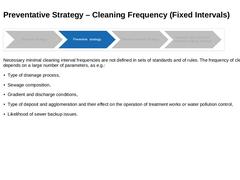
|
(Image: Arrow Preventive strategy) Necessary minimal cleaning interval frequencies are not defined in sets of standards and of rules. The frequency of cleaning depends on a large number of parameters, as e.g.: -
Type of drainage process,
-
Sewage composition,
-
Gradient and discharge conditions,
-
Type of deposit and agglomeration and their effect on the operation of treatment works or water pollution control,
-
Likelihood of sewer backup issues.
|
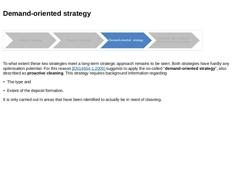
|
(Image: Arrow Demand-oriented strategy) It remains to be questioned to what extent the reactive and preventive strategies correspond to a long-term, planned approach. Both strategies show only a small potential for optimisation. For this reason, the application of the so-called ‘demand-oriented strategy’ ( [EN14654-1:2005]) is recommended, which is also referred to as ‘proactive cleaning’. The application of this strategy requires an analysis of the … |
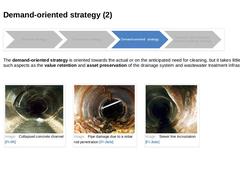
|
(Image: Arrow Demand-oriented strategy) The demand-oriented strategy is oriented towards the actual or on the anticipated need for cleaning, but it takes little account of such aspects as the value retention and asset preservation of the drainage system and wastewater treatment infrastructure. |
(Image: Collapsed concrete channel) |
(Image: Pipe damage due to a rebar rod penetration) |
(Image: Sewer line incrustration) |
|
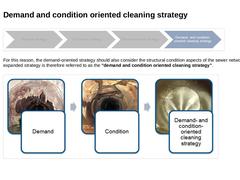
|
(Image: Arrow Demand- and condition oriented cleaning strategy) For this reason, the demand-oriented strategy should also consider the structural condition aspects of the sewer network. This expanded strategy is therefore referred to as the “demand and condition oriented cleaning strategy”. (Image: Demand and condition oriented cleaning strategy) |
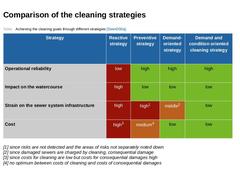
|
(Table: Achieving the cleaning goals through different strategies) |
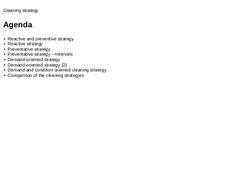
|
|
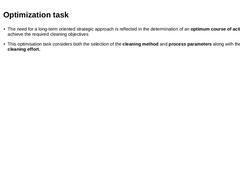
|
(Image: Picto Optimisierung) |

|
Optimization of cleaning effort is a dynamic process through which: |
(Image: Picto Pfeile Blau) |
(Image: Icon: Recht) |
(Image: Picto Wirtschaft) |
|---|
|
Maintaining the hydraulic capacity of the drainage system |
Proof of the operator's duty of care and minimisation of reactive cleaning measures to an acceptable level |
Reduction of cleaning costs |
|
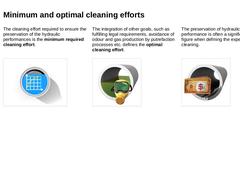
|
The cleaning effort required to ensure the preservation of the hydraulic performances is the minimum required cleaning effort. The integration of other goals, such as fulfilling legal requirements, avoidance of odour and gas production by putrefaction processes etc. defines the optimal cleaning effort. The preservation of hydraulic performance is often a significant target figure when defining the expense of cleaning. (Image: Picto Hydraulisch) |
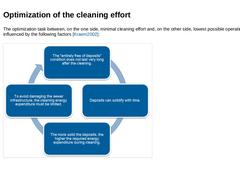
|
The optimization task between, on the one side, minimal cleaning effort and, on the other side, lowest possible operating problems is influenced by the following factors [Kraem2002]: (Image: Optimization of the cleaning effort) |

|
(Table: Advantages and disadvantages of short and long cleaning intervals) |
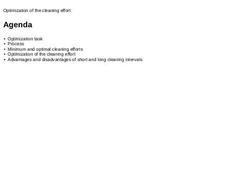
|
|
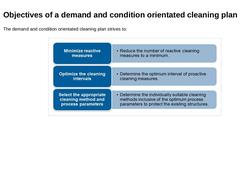
|
A demand- and condition-oriented cleaning plan thus pursues the objective: |
Minimize reactive measures |
|
|
Optimize the cleaning intervals |
|
|
Select the appropriate cleaning method and process parameters |
|
|

|
The development of a demand- and condition-oriented cleaning plan for drain and sewer systems can be divided into four steps within the management process: ![]()
|
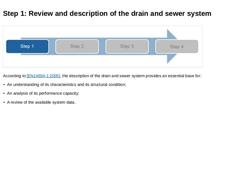
|
(Image: Arrow Step 01) A detailed and consistent inventory and description of the drainage system enables the network operator to locate the sections of sewers and drains where preventive cleaning is to be carried out and to estimate the frequency of cleaning. In this context, it must include the following a) knowledge of the properties and structural condition of the drainage system; b) an analysis of the system's performance; c) a review of existing … |
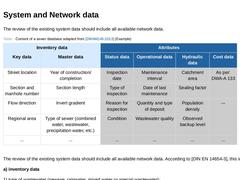
|
The review of the existing system data should include all available network data. According to [DIN EN 14654-3], this includes: a) inventory data 1) type of wastewater (sewage, rainwater, mixed water or special wastewater); 2) properties of the sewer (shape, size, gradient, depth, material, etc.), presence and properties of overflows from combined sewers and other systems; 3) environmentally relevant aspects at the location of the sewer (e.g. water protection … |
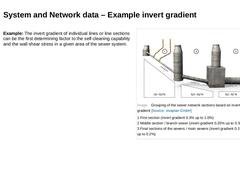
|
Example: The invert gradient of individual lines or line sections can be the first determining factor to the self-cleaning capability and the wall shear stress in a given area of the sewer system. (Image: Grouping of the sewer network sections) |
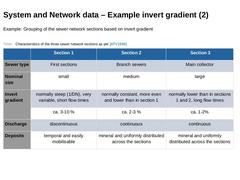
|
Initial sections usually have a gradient of between 3 ‰ and 10 ‰, while sections in the middle network area have a gradient of between 2 ‰ and 3 ‰. In the last sections of the sewers with larger cross-sections (branch collectors, main collectors, etc.), the gradient is chosen to be between 1 ‰ and 2 ‰, or even lower in some cases, depending on the topographical conditions. The table on this page shows the main characteristics of the three sewer network … |
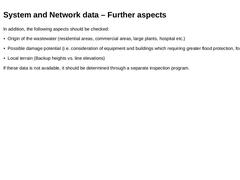
|
In addition, the following aspects should be checked: Origin of the wastewater (residential areas, commercial areas, large plants, hospital etc.) Possible damage potential (i.e. consideration of equipment and buildings which requiring greater flood protection, for example) Local terrain (Backup heights vs. line elevations) (Image: Origin of the wastewater (residential areas, commercial areas, large plants, hospital etc.)) (Image: Possible damage potential (… |

|
The analysis of the previous cleaning methods should additionally be based on interviews with the cleaning staff to document the "on-site knowledge".
Information regarding sections requiring frequent cleaning needs to be documented in incident reports and should include the location, frequency, effect and cause of disturbances. (Image: Exchange of information between planners and operational staff) |
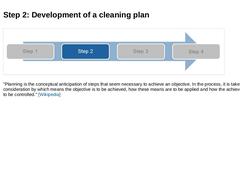
|
(Image: Arrow Step 02) "Planning is the conceptual anticipation of steps that seem necessary to achieve an objective. In the process, it is taken into consideration by which means the objective is to be achieved, how these means are to be applied and how the achieved results are to be controlled." [Wikipedia] |
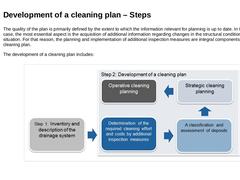
|
The quality of the plan is largely determined by the up-to-dateness of the information relevant to the planning. This applies in particular to information on changes in the structural condition and the deposit situation. If the data and information available from step 1 is insufficient, further investigations may be necessary to determine a) the extent of the debris or obstacles, including the deposits in the lateral connections of the sewer; b) the … |
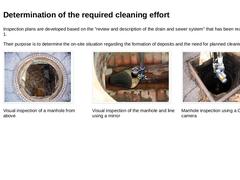
|
Inspection plans are developed based on the "review and description of the drain and sewer system" that has been realised in step 1. Their purpose is to determine the on-site situation regarding the formation of deposits and the need for planned cleaning measures. (Image: Schachtinspektion Ablagerungen) Manhole inspection by visual observation from above (Image: Schachtinspektion durch Inaugenscheinnahme und Spiegelung der Haltung) Manhole inspection … |
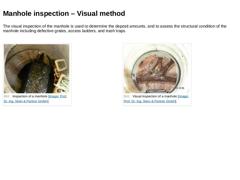
|
The visual inspection of the manhole is used to determine the deposit amounts, and to assess the structural condition of the manhole including defective grates, access ladders, and trash traps. (Image: Inspection of a manhole) (Image: Visual inspection of a manhole) |